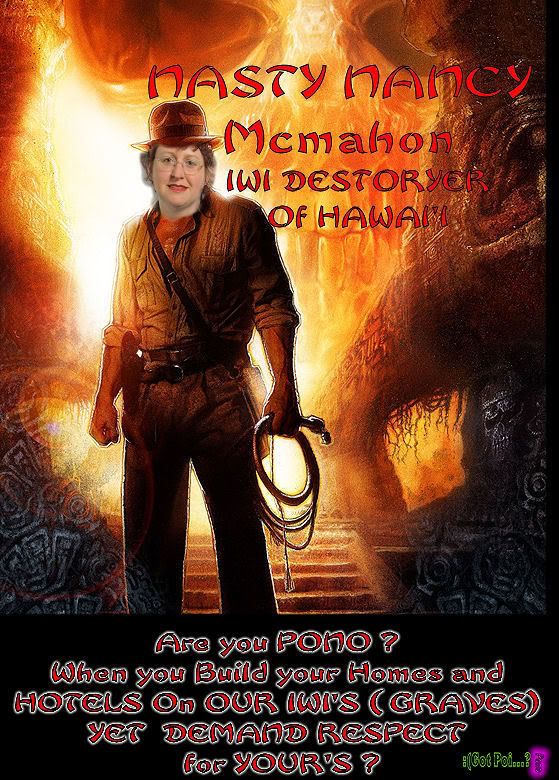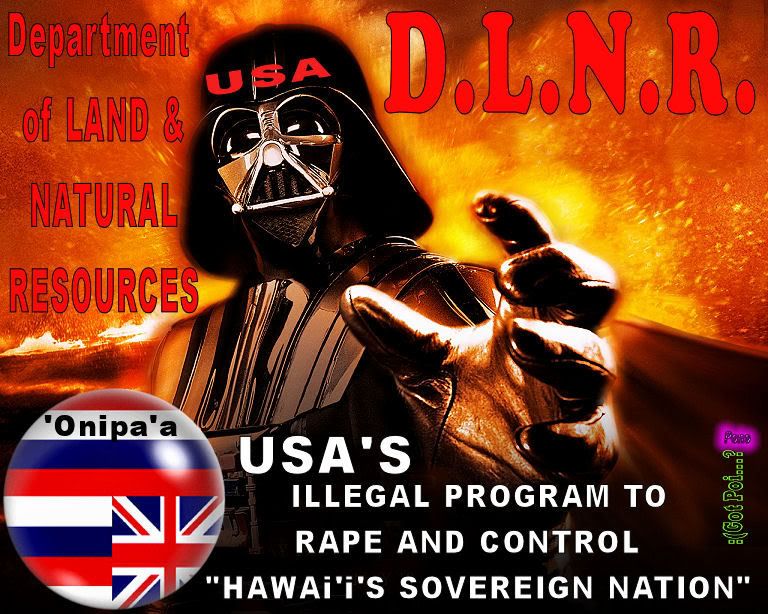

Aloha Ms. Thielen,
I watched the news on Saturday night. April 3, 2010 and I was compelled
to write this email to you in response. Not once did I hear
accountability for the actions or inactions of the State Historic
Preservation Division. It is important to set the record straight
with you from someone who actually heard and witnessed things while
employed at SHPD. As someone who spent their life in honoring,
preserving and protecting our Hawaiian cultural resources, I was honored
to work for our Kupuna AT shpd. However, once in the
only agency dedicated to the preservation of our historic and cultural
resources, I was disillusioned by the lack of sound leadership and basic
preservation principles applied in daily decision making. The lack of
funding and excuses that I heard you speak
of skirted the real issues afflicting the Division. Therefore, I will
ask questions of you which will help me and community to find out how
these atrocities occurred at our cultural sites. . Though findings of
concern on management or 6E were acknowledged,
the National Parks Service (NPS) had no authority to
address them. All who read this email must understand that the NPS
review only addressed federal issues.
On April 3, you mentioned that it was unreasonable for the NPS to expect SHPD to comply while the State is
under such difficult economic times. My question to you is this; does
that mean that you, as DLNR Chair, expect NPS to lower their
expectations of compliance for Hawaii alone? How fair would that be
for the rest of the states who are in compliance? When you took over as
Chair of DLNR, at that time you knew the problems SHPD faced. Your
first months as Chair, you spoke to staff at SHPD
of which I was a member and said you would take personal interest in
bringing SHPD back into a functional body. Your main directive was to
bring the number of backlog reviews down. However, you did not mention
how to accomplish that task at the speed you
wanted while keeping the integrity of the process which includes proper
and thorough research of cultural significance of areas being reviewed.
As Chair, did you give adequate consideration to the price that would
be paid by compromising our priceless resources?
The direct result of this type of process caused the fiasco at Hawea
Complex and other sites. The individual who did the review was the same
person responsible for doing over 100 reviews per month. Were these
reviews accurate and reflective of sound preservation
practices? This same individual was responsible for the Makakilo
Extension that caused adverse community reaction as a trail would have
been compromised. Did Deputy SHPO McMahon check this individual's work
before letters were sent out? If she had, she
would have noticed that out of 100 reports in October of 2008, 90% were
no effect, about 45% had errors which ranged from wrong TMK's and wrong
projects referenced in the subject and in the body of the review,
little to no research on the subject of the review,
just to name a few of the mistakes. How could this happen? Very
easily, as the DLNR Chair wanted the backlogs down, number of reviews
went up but quality of work went down. This individual was lauded for
her quantity of work but little or no quality was
demonstrated. Who is responsible for allowing this to occur? This is a
management problem not a lack of funding!
In addition, you mentioned that SHPD has been unable to get qualified
people and the hint was that you may have to bring in qualified
individuals from elsewhere to achieve compliance. There are qualified
people here but the fact is that those individuals chose
not to work for SHPD under the management currently in place. Could
some of the reasons be that the current management has proven in a
number of cases to be unqualified themselves? Who will take
responsibility for allowing disparity in reprimands and or privileges?
For instance, Ms McMahon gave one employee 15 days suspension for
having files related to school work on her computer. This individual
was working toward a master’s degree that would have been an asset to
the Division. This individual did not do her homework
while at work but decided to have the files at her fingertips in case
ideas presented itself. Another individual was caught by 6 other staff
playing computer games during work hours for an extended period of time
and over several months on a daily bases.
This individual received no reprimand but was just told not to get
caught. While one was furthering her education to enhance her job
skills and was given such harsh punishment, one would think that the
individual that was playing games would have been given
an even harsher punishment if fairness was the goal. Did you know that
Ms. McMahon had a confidential performance review of an employee on the
shared drive which meant that anyone in that department had access to
it? Other disparities include allowing Ms.
McMahon to live on Kauai while her primary place of employment should
have been on Oahu . Thousands of tax payer’s dollars were spent in
bringing her back and forth from Kauai . An employee is responsible for
travel to and from work and if an employee chooses
to live off island, then it is the employee's responsibility for the
cost. Why was Ms. McMahon given preferential treatment? Another
example of disparity includes allowing an employee on Maui to work from
home, create their own schedule outside of standard
State hours even though the Maui office is within reasonable distance
from her home. Why was this employee given preferential treatment?
Qualified individuals, observing the disparity in which SHPD is
run, would not risk their professional reputation in association with
such an agency. Is this lack of funding? No, it is lack of sound
management practices.
Ms. Cayan, Cultural Branch Chief, missed recording for the OIBC meeting
minutes an action that was voted upon by the Council. That oversight was
not minor. The minutes should reflect the spirit of the meeting and at
the very least include all actions. Since
the meetings are taped, it is hard to believe an action could be
missed. Minutes are legal documents and should be treated as such. In
this case they were not reflective of the actions taken by the Council.
Was this due to lack of funding? No, it was lack
of due diligence from an individual whose job it was to ensure these
types of errors do not occur within her realm of responsibility as
Cultural Branch Chief.
It was communicated to me that there was an incident where Ms. Cayan,
Cultural Branch Chief, acted on behalf of the State and called an
individual's condominium manager to insist that a photo this individual
placed on the web be taken off. The photo was taken
of a burial site that was uncovered by construction but Kupuna iwi were
not photographed. Is this action one in which a State employee is
authorized to take? Is it legal or ethical for a State employee to
contact the management responsible for a person's
place of abode without the individual's knowledge? The individual did
not break the law. Was this lack of funding? No, it was not.
After I left SHPD, there was a case I was particularly concerned about
which involved a Kupuna discovered at Hookena Beach in Kona. Following
burial protocol, Kupuna are to be reentered in the area in which they
were discovered or as close as possible but with
in the same Ahupua`a at the very least. However, I
learned that this Kupuna was reburied at Honaunau, several Ahupua`a
north. It is SHPD’s responsibility to ensure that the connection for
familial ties to that Kupuna are kept and not broken by
displacing the iwi and erasing the ancestral markers that are the
physical reminder of our Kupuna’s resting place. It is not about doing
what is easy but rather what is traditionally appropriate and this did
not occur. As the Cultural Branch Chief, Ms. Cayan
should have advocated for each Kupuna to be reburied within the
Ahupua`a from which they originated from. Was this due to lack of
funding? No, it was lack of burial rites knowledge.
Is it acceptable practice for an individual without proper credentials to write an Archaeological Inventory Review
for 6E?
This was done by full knowledge and acceptance of the Deputy SHPO
and Administrator.
Serious concerns raised by the management practice at SHPD led the Office of the Interior in Washington DC to ask
for immediate review of SHPD. The result was to send Paula Creech from
the National Park Service to Hawaii .
Ms Creech spent 9 months in Hawaii . Did you, as
DLNR Chair, take this opportunity to garner all of her insight and
expertise to help SHPD come into compliance?
Did you as DLNR Chair, meet with her on a weekly basis to see
what measures could be taken?
Did Ms. Aiu, SHPD Administrator, interact with her on a daily
basis and become involved in meaningful conversations for corrective
actions?
Knowing of the compliance issues facing SHPD, Ms. Creech
presented a perfect opportunity to receive guidance to bring SHPD into
compliance. Why then after a nine month period of in house guidance is
SHPD now faced with a high risk status and possible
loss of federal funding? How then does DLNR and SHPD explain to the
community how such an opportunity was not wholeheartedly embraced?
What this inaction has created is a dire situation for receiving
federal funding. This situation was not brought about by lack of funding
but by poor managerial decision making and not taking preservation and
protection as a priority.
Where is the Policy and Procedure Manual for SHPD that speaks to the procedures that ALL must follow without
exception in conducting business?
There was an attempt by committee to provide such policy and
procedures but management did not take the committee seriously and as a
result only a few procedures were written.
This manual would help management bring consistency
to operations and how members of the departments within SHPD must
perform their duties.
Without such a manual, members of the management team issued
reprimands or decisions based upon personal biases and not in accordance
to fairness or to the best interest of the spirit of preservation.
As I have followed your responses to criticism over the past months of SHPD, you give credit to the Division for the
accomplishments of reburials of Kupuna.
In 2008-2009, there were funds appropriated by the State
Legislature for reburials of $38,000.00 of which I, as a SHPD Cultural
Specialist in charge of reburials, used less than $2,000.00 leaving
$36,000.00. To this day, I do not know what became of
the $36,000.00 allocated specifically for reburials. What
did the SHPD administrator do with the rest of the funds?
While under my supervision, I reburied over 60% of the Kupuna iwi
from the Oahu repository and had made arrangements for homes for
another 33% which left the Division on my departure with a mere 7% to
deal with.
The accomplishments you speak of regarding reburials were done by
one employee.
I was able to secure sites with no monetary funds, even though
monetary funds were allocated for these reburials, and it was done with
community input.
Once again is this funding constraints? No, money
was allocated but was misappropriated by SHPD management.
I could give example after example of how SHPD has been complicit in
creating or prolonging the problems affecting proper preservation and
protection. Funding is only one of many problems that needs to be
addressed from a State level. I will go back to my
original question of responsibility. Who is responsible for the
concerns I have mentioned?
Questions:
- What will you, as DLNR Chair, do about the management team (Administrator, SHPO and Cultural Branch Chief) that
have demonstrated poor decision making?
- How will you, DLNR Chair, solve the problem of
hiring of staff when clearly the problem is not lack of
qualified applicants or funding but rather no one wants to work under
the present condition and management?
3. What measures will you, DLNR Chair, enact to assure the citizens of this
State that the spirit of preservation for our cultural resources are
respected and protected?
4. What corrective actions will you, DLNR Chair, take to bring SHPD in
compliance to not only federal funding but State laws and Rules and more
importantly to the spirit in which the laws and rules
were created?
I look forward to your response to address my questions.
Aloha,
Kaleo Paik, Cultural Practitioner





![Reblog this post [with Zemanta]](http://img.zemanta.com/reblog_e.png?x-id=c1a165b8-46ef-4f9a-92b5-fea238ef8257)








 20px; float: right;" style="margin-left: 20px; margin-right: 20px; float: right;"">Points for Hula Kahiko & Hula 'Auana
20px; float: right;" style="margin-left: 20px; margin-right: 20px; float: right;"">Points for Hula Kahiko & Hula 'Auana margin-left: 20px; margin-right: 20px;" style="float: right; margin-left: 20px; margin-right: 20px;"">Hula Kahiko Rules
margin-left: 20px; margin-right: 20px;" style="float: right; margin-left: 20px; margin-right: 20px;"">Hula Kahiko Rules![Reblog this post [with Zemanta]](http://img.zemanta.com/reblog_e.png?x-id=4d70cc38-fdeb-48da-9c66-6598e0fc4249)